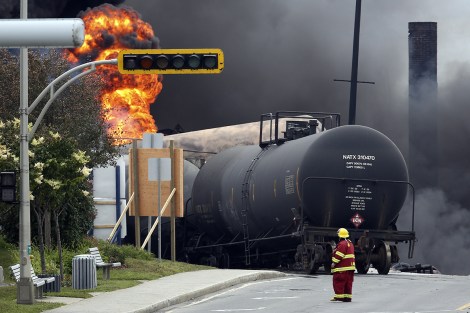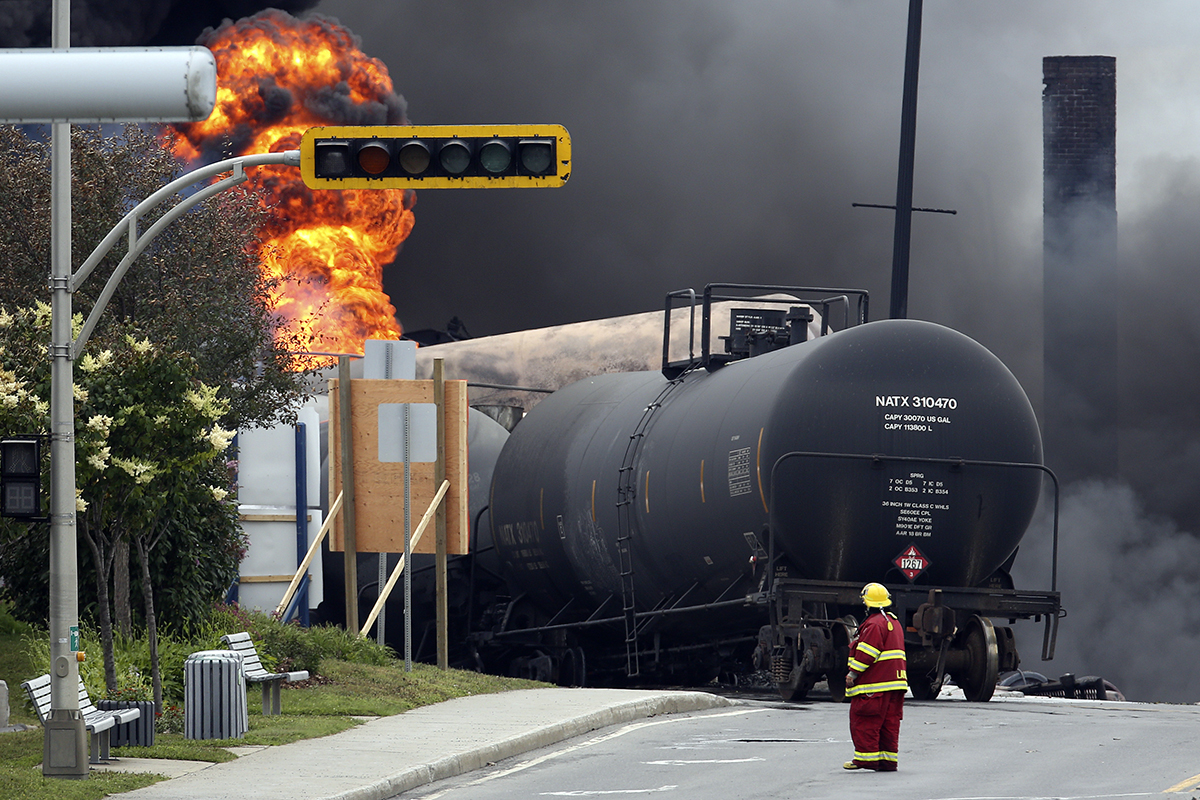
Reuters/Mathieu BelangerA firefighter walks past a burning train at Lac-Mégantic, Quebec.
The latest disaster caused by the transport of oil across North America has wrecked the town of Lac-Mégantic in Quebec. A driverless train loaded with crude from the Bakken oil fields of North Dakota derailed and exploded early Saturday in the town’s center.
Dozens of buildings were leveled and at least five people were killed, while 40 more were still missing as of Monday morning. The fracked oil was en route to New Brunswick, which is home to the largest oil refinery in Canada. From Reuters:
The train, which did not have an engineer aboard when it derailed, was hauling 72 tanker cars of crude from North Dakota to eastern Canada. It rolled downhill from an overnight parking spot, gathered speed and derailed on a curve in the small town of Lac-Megantic at 1 a.m. on Saturday.
Each car carried 30,000 gallons of crude oil. Four caught fire and exploded in an orange and black fireball that mushroomed hundreds of feet into the air and flattened dozens of buildings, including a popular bar.
“It looks like a war zone here,” said Canadian Prime Minister Stephen Harper.
The disaster plunged the media into debate: Is it safer to move oil through underground pipelines (à la Mayflower, Kalamazoo, and Keystone XL), or to move it by rail?
Frackers and tar-sands miners are extracting record amounts of oil in America and Canada. Existing pipelines can’t carry the whopping bounty to refineries, so energy companies are seeking to lay lattices of new pipes. Meanwhile, the glut of liquid hydrocarbons is being loaded onto trains, which are being sent vast distances — and are triggering high-profile spills and accidents.
The Toronto Globe and Mail argues in the wake of the Lac-Mégantic disaster that “[p]ipelines are the safest way of transporting oil and natural gas, and we need more of them, without delay.” The New York Times considers the pipeline-vs.-train question more impartially, quoting environmental experts:
Edward Whittingham, the executive director of the Pembina Institute, an environmental group based in Calgary, Alberta, said there was not conclusive research weighing the safety of the two shipment methods.
“The best data I’ve seen indicates,” he said, “depending on your perspective, both are pretty much as safe as each other, or both are equally unsafe. There’s safety and environmental risks inherent in either approach.”
Accidents involving pipelines, Mr. Whittingham said, can be more difficult to detect and can release greater amounts of oil. Rail accidents are more frequent but generally release less oil.
But the comparison obfuscates an obvious reality: The oil can’t be moved safely at all. (Same goes for natural gas.)
After a string of pipeline and rail accidents in recent years, it’s clear that letting the energy industry move incendiary bulk fluids around the continent is like tossing a book of matches into the crib to keep little Johnny happy while his folks stare at the television. And that’s without even considering the climate impacts of the fossil-fuel mining binge, or the many hazards of fracking.
The weekend tragedy is a reminder that the energy industry can’t be trusted to do anything safely, let alone transport oil.



